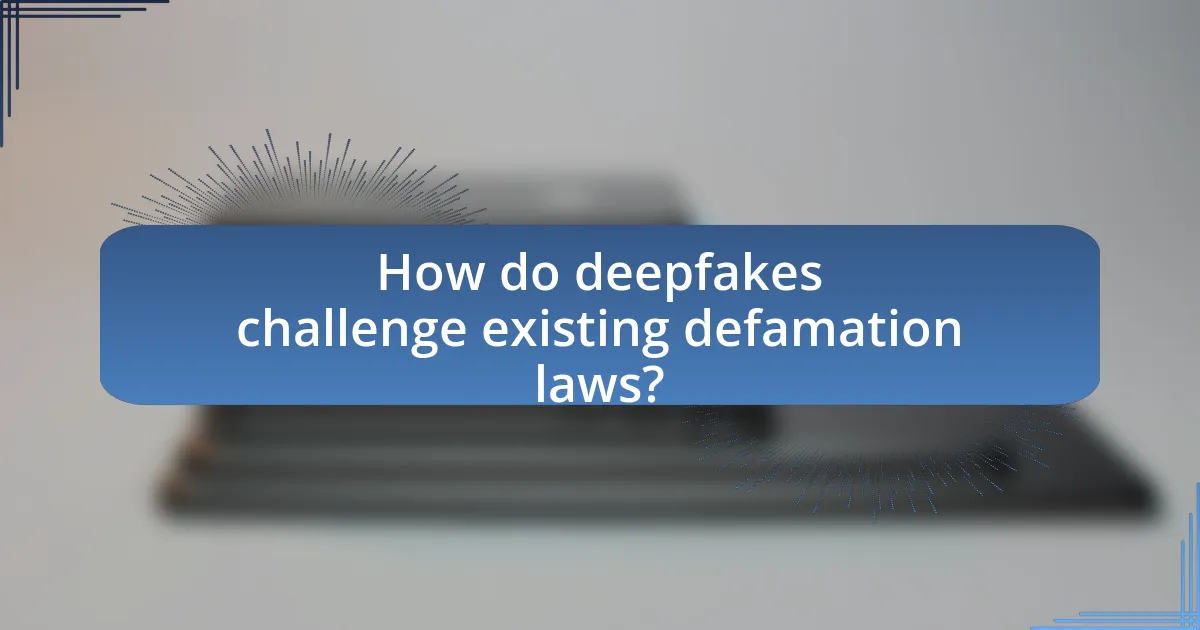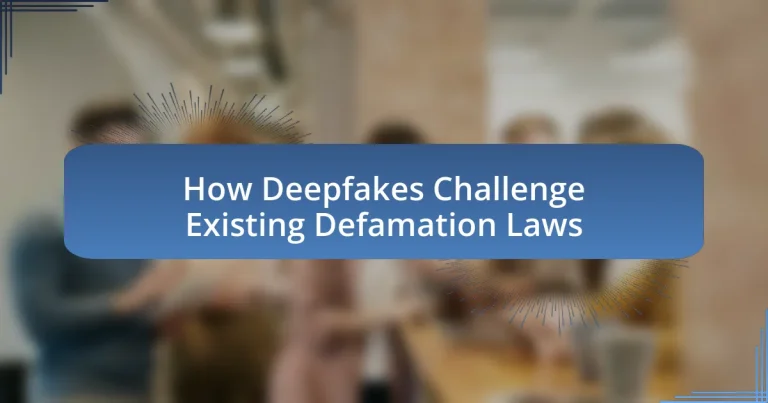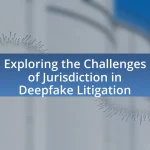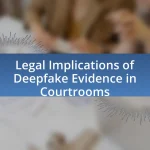Deepfakes, a form of synthetic media created using artificial intelligence, pose significant challenges to existing defamation laws by complicating the identification of perpetrators and the authenticity of content. Traditional defamation laws require proof of false statements that harm an individual’s reputation, but deepfakes blur the lines between reality and fabrication, making it difficult to establish truth and accountability. This article explores the nature of deepfakes, the technologies behind their creation, and the inadequacies of current legal frameworks in addressing the unique challenges they present, including the difficulties in proving defamation and identifying responsible parties. Additionally, it discusses potential legislative measures and best practices for individuals to protect themselves from deepfake defamation.

How do deepfakes challenge existing defamation laws?
Deepfakes challenge existing defamation laws by complicating the identification of the perpetrator and the authenticity of the content. Traditional defamation laws require proof that a false statement was made about an individual, but deepfakes blur the line between reality and fabrication, making it difficult to ascertain whether the content is genuine or manipulated. For instance, a deepfake video can convincingly depict an individual saying or doing something they never did, which can lead to reputational harm. This manipulation raises questions about accountability, as the technology allows for the creation of misleading content without clear attribution to the creator, thereby undermining the principles of defamation law that rely on the ability to trace harmful statements back to their source.
What are deepfakes and how are they created?
Deepfakes are synthetic media in which a person’s likeness is replaced with someone else’s, often using artificial intelligence techniques. They are created primarily through deep learning algorithms, particularly Generative Adversarial Networks (GANs), which involve two neural networks: one generates fake content while the other evaluates its authenticity. This process requires a substantial dataset of images or videos of the target individual to train the model effectively, enabling the generation of realistic and convincing alterations. The technology has raised significant concerns regarding misinformation and defamation, as it can be used to create misleading representations that challenge existing legal frameworks.
What technologies are used in the creation of deepfakes?
Deepfakes are primarily created using artificial intelligence technologies, specifically deep learning algorithms. These algorithms, particularly Generative Adversarial Networks (GANs), enable the synthesis of realistic images and videos by training on large datasets of existing media. GANs consist of two neural networks, a generator and a discriminator, that work together to produce high-quality fake content. Additionally, techniques such as autoencoders and facial recognition software are often employed to enhance the accuracy and realism of the generated deepfakes. The effectiveness of these technologies is evidenced by their ability to produce videos that can be indistinguishable from real footage, raising significant concerns regarding misinformation and defamation.
How do deepfakes differ from traditional forms of media manipulation?
Deepfakes differ from traditional forms of media manipulation primarily in their use of advanced artificial intelligence to create hyper-realistic alterations of video and audio content. Traditional media manipulation often involves simpler techniques such as editing, cropping, or using filters, which can be more easily detected and debunked. In contrast, deepfakes utilize deep learning algorithms to generate synthetic media that can convincingly mimic real individuals, making it significantly harder for viewers to discern authenticity. This technological sophistication raises unique challenges for defamation laws, as the realistic nature of deepfakes can lead to more severe reputational harm compared to conventional manipulated media.
What is defamation and how is it defined legally?
Defamation is a false statement presented as a fact that injures a party’s reputation. Legally, defamation is defined as either libel (written defamation) or slander (spoken defamation), and it requires the plaintiff to prove that the statement was made with negligence or actual malice, depending on the status of the plaintiff. In the United States, the landmark case New York Times Co. v. Sullivan established that public figures must demonstrate actual malice to win a defamation lawsuit, while private individuals need only show negligence. This legal framework underscores the importance of truth and the burden of proof in defamation cases.
What are the key elements that constitute defamation?
The key elements that constitute defamation are a false statement, publication to a third party, and harm to the subject’s reputation. A false statement refers to an assertion that is not true, which can be verbal (slander) or written (libel). Publication means that the statement was communicated to someone other than the person it is about, establishing that the information was disseminated. Harm to reputation indicates that the false statement has caused damage to the individual’s standing in the community or among peers. These elements are essential for a successful defamation claim, as established in legal precedents such as New York Times Co. v. Sullivan, which emphasizes the necessity of proving these components for a defamation case to be valid.
How do different jurisdictions define defamation?
Different jurisdictions define defamation as a false statement that injures a person’s reputation. In the United States, defamation is categorized into libel (written) and slander (spoken), requiring the plaintiff to prove that the statement was made with actual malice if the plaintiff is a public figure, as established in the landmark case New York Times Co. v. Sullivan (1964). In the United Kingdom, defamation law is governed by the Defamation Act 2013, which emphasizes the need for the statement to cause serious harm to the claimant’s reputation. In Australia, defamation is defined similarly, with the requirement that the statement must be published to a third party and must cause harm, as outlined in the Uniform Defamation Laws adopted by various states. Each jurisdiction has specific elements and defenses that shape how defamation is interpreted and enforced.
Why are existing defamation laws inadequate in addressing deepfakes?
Existing defamation laws are inadequate in addressing deepfakes because they often rely on traditional notions of truth and falsehood that do not account for the complexities of digitally manipulated content. Deepfakes can create realistic but entirely fabricated representations of individuals, making it difficult to prove that a statement is false or damaging in a legal context. For instance, the legal standard for defamation typically requires the plaintiff to demonstrate that the statement in question is false and that it caused harm, but deepfakes blur the lines of authenticity, complicating the ability to establish these elements. Additionally, many jurisdictions lack specific legal frameworks that address the unique challenges posed by deepfakes, such as the rapid dissemination of harmful content and the anonymity of creators, which further hampers effective legal recourse.
What challenges do deepfakes pose to proving defamation?
Deepfakes complicate the proof of defamation by blurring the line between reality and fabrication, making it difficult to establish the authenticity of evidence. The technology allows for the creation of highly realistic but false representations of individuals, which can mislead courts and juries regarding the intent and impact of the alleged defamatory statements. For instance, a deepfake video could convincingly depict someone saying or doing something harmful, yet the individual may not have ever made those statements, thus challenging the plaintiff’s ability to prove that the content is both false and damaging. Additionally, the rapid dissemination of deepfakes through social media can amplify reputational harm before the victim has a chance to respond, further complicating legal recourse.
How do deepfakes complicate the identification of the perpetrator?
Deepfakes complicate the identification of the perpetrator by enabling the creation of highly realistic but fabricated audio and visual content that can mislead viewers about the true source of the material. This technology allows individuals to manipulate images and sounds, making it difficult to trace the original creator or intent behind the content. For instance, a study by the University of California, Berkeley, found that deepfake technology can produce videos that are indistinguishable from real footage, which can be used maliciously to impersonate individuals or spread false information. Consequently, the anonymity afforded by deepfake creation tools obscures accountability, making it challenging for law enforcement and legal systems to identify and prosecute those responsible for defamation or other malicious acts.
What are the potential legal implications of deepfakes on defamation cases?
Deepfakes can significantly complicate defamation cases by blurring the lines between reality and fabrication, making it challenging to establish the truth. The legal implications arise from the potential for deepfakes to create misleading representations of individuals, which can damage reputations and lead to false claims of defamation. Courts may struggle to determine liability, as traditional defamation laws require proof of false statements made with negligence or actual malice, which can be difficult to ascertain when the content is digitally manipulated. Furthermore, the rise of deepfakes may necessitate updates to existing laws to address the unique challenges they present, such as the need for clearer definitions of harm and intent in the context of digital media.
How might courts interpret deepfakes in defamation lawsuits?
Courts may interpret deepfakes in defamation lawsuits as a new form of harmful misinformation that can cause reputational damage. The legal framework for defamation requires proving that a false statement was made with actual malice or negligence, and deepfakes complicate this by blurring the line between reality and fabrication. For instance, in cases where a deepfake video falsely portrays an individual engaging in illegal or immoral behavior, courts could recognize the potential for significant harm to the victim’s reputation, thus allowing for claims of defamation. Legal precedents, such as the case of New York Times Co. v. Sullivan, establish that public figures must demonstrate actual malice, which could be challenging with deepfakes due to the difficulty in proving intent behind the creation and distribution of such content. Additionally, the rise of deepfakes has prompted discussions among lawmakers about updating defamation laws to address the unique challenges posed by this technology, indicating a potential shift in judicial interpretation.
What precedents exist regarding digital manipulation and defamation?
Precedents regarding digital manipulation and defamation include cases where manipulated media has been used to harm reputations, leading to legal actions. Notably, the case of “Nussenzweig v. diCorcia” established that the unauthorized use of manipulated images can lead to defamation claims, emphasizing the importance of consent in media representation. Additionally, the “Gordon v. Marra” case highlighted how digitally altered images can mislead audiences and result in reputational damage, reinforcing the legal recognition of harm caused by digital manipulation. These cases illustrate the evolving legal landscape as courts address the implications of technology on defamation laws.
How can lawmakers adapt existing defamation laws to address deepfakes?
Lawmakers can adapt existing defamation laws to address deepfakes by explicitly including provisions that recognize the unique characteristics of deepfake technology. This adaptation could involve defining deepfakes as a distinct category of harmful content that can cause reputational damage, thereby allowing victims to seek legal recourse. For instance, jurisdictions like California have already introduced legislation targeting deepfakes, which demonstrates a legislative trend towards recognizing the potential for deepfakes to mislead and defame individuals. By establishing clear standards for liability and evidence requirements specific to deepfakes, lawmakers can enhance the effectiveness of defamation laws in the digital age.
What legislative measures could be implemented to combat deepfake defamation?
Legislative measures to combat deepfake defamation could include the establishment of specific laws that criminalize the creation and distribution of deepfakes intended to harm an individual’s reputation. Such laws would define deepfake technology and outline penalties for malicious use, similar to existing laws against libel and slander. Additionally, regulations could mandate clear labeling of synthetic media to inform viewers when content has been altered, thereby reducing the potential for deception.
For instance, California’s AB 730, enacted in 2019, already addresses the malicious use of deepfakes in the context of election interference and non-consensual pornography, serving as a model for broader legislation. This law demonstrates the feasibility of targeted legal frameworks that can adapt to technological advancements while protecting individuals from defamation.
How can technology be leveraged to enhance legal frameworks against deepfakes?
Technology can be leveraged to enhance legal frameworks against deepfakes by implementing advanced detection algorithms and blockchain verification systems. Detection algorithms, such as those developed by researchers at the University of California, Berkeley, utilize machine learning to identify manipulated media with high accuracy, enabling legal authorities to quickly assess the authenticity of content. Blockchain technology can provide a secure and immutable record of original media, allowing for easy verification of authenticity and ownership, which is crucial in legal disputes involving deepfakes. These technological advancements can support the enforcement of existing defamation laws by providing concrete evidence of manipulation, thereby strengthening legal actions against malicious deepfake creators.
What are the best practices for individuals to protect themselves from deepfake defamation?
To protect themselves from deepfake defamation, individuals should employ a combination of proactive measures and technological tools. First, individuals must monitor their online presence regularly to identify any unauthorized or manipulated content. Utilizing reverse image search tools can help detect deepfakes or altered images. Additionally, individuals should maintain strong privacy settings on social media platforms to limit the exposure of personal information that could be used to create deepfakes.
Furthermore, educating oneself about deepfake technology and its implications can enhance awareness and preparedness. Engaging with platforms that offer deepfake detection services can also provide an additional layer of security. According to a study by the University of California, Berkeley, deepfake detection algorithms have shown effectiveness in identifying manipulated media, underscoring the importance of leveraging such technologies. By implementing these practices, individuals can significantly reduce the risk of becoming victims of deepfake defamation.
How can individuals verify the authenticity of media before sharing?
Individuals can verify the authenticity of media before sharing by conducting reverse image searches, checking metadata, and cross-referencing information with credible sources. Reverse image searches, such as those offered by Google Images, allow users to find the original source of an image, revealing whether it has been altered or misrepresented. Analyzing metadata can provide insights into the creation date and editing history of a media file, helping to identify potential manipulation. Additionally, cross-referencing claims with reputable news outlets or fact-checking websites, like Snopes or FactCheck.org, can confirm the accuracy of the information presented. These methods are essential in combating misinformation, especially in the context of deepfakes, which can easily mislead viewers and challenge existing defamation laws.
What steps can be taken to respond to deepfake defamation effectively?
To respond to deepfake defamation effectively, individuals should first gather evidence of the deepfake content, including timestamps and the original media. This documentation is crucial for establishing the false nature of the content. Next, individuals should report the deepfake to the platform hosting it, as many social media sites have policies against manipulated media. Legal action may also be pursued by consulting with a lawyer specializing in defamation or digital rights, as existing laws can sometimes be applied to deepfake cases. Additionally, public awareness campaigns can help mitigate damage by clarifying the truth to the affected audience. These steps are supported by the increasing recognition of deepfakes as a serious issue, prompting platforms and lawmakers to take action against such forms of defamation.


